Fawaris, Delta Cygni A (δ Cyg A), is the primary component in a triple star system located about 165 light years away in the constellation Cygnus. With a combined apparent magnitude of 2.87, the star system is the fourth brightest point of light in Cygnus, after Deneb, Sadr, and Aljanah. It forms the Northern Cross, one of the most familiar asterisms in the northern summer sky, with the three brighter Cygnus stars and the fainter Albireo.
Star system
Delta Cygni is a triple star system composed of two brighter components – Delta Cygni A and Delta Cygni B – and a 12th magnitude companion. The faint companion appears at a wider separation but has a similar proper motion to the main pair.
The primary component, Fawaris (Delta Cygni A) is a blue giant star of the spectral type B9 III. The star has a mass of 2.93 solar masses and a radius 5.13 times that of the Sun. With a surface temperature of 10,150 K, it shines with 155 solar luminosities.
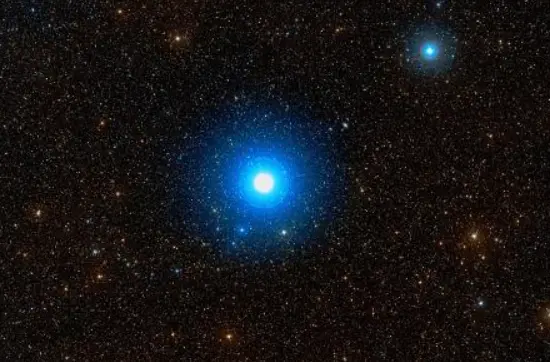
Fawaris (Delta Cygni), image: Wikisky
Fawaris is a fast spinner. It spins about 60 times faster than the Sun, with a projected rotational velocity of 135 km/s at the equator.
Delta Cygni B is a yellow-white main sequence star of the spectral type F1 V. Shining at magnitude 6.33, the star is near the limit of unaided eye visibility. It has a mass 1.5 times that of the Sun and is about 6 times more luminous.
The two components take 780.27 years to complete an orbit around the common centre of mass. They orbit each other at an average separation of 157 astronomical units (84 – 230 AU). The semi-major axis (longest diameter) of their orbit is 3 arcseconds. The two stars together present as a white subgiant of the spectral type A0 IV.
Delta Cygni A and Delta Cygni B are both suspected variable stars. Fawaris was reported to vary between magnitudes 2.85 and 2.89, and the companion, from magnitude 6.3 to 8.5. The variations in brightness have not been confirmed.
The faintest component is a class K main sequence star with a mass two-thirds that of the Sun.
Facts
Fawaris is part of the Northern Cross, an asterism that outlines the main body of Cygnus, the Swan. Fawaris, Sadr (Gamma Cygni) and Aljanah (Epsilon Cygni) form the crossbeam, the bright Deneb (Alpha Cygni) sits at the top of the cross and Albireo (Beta Cygni) is at the base. All five are evolved stars that came to the end of their main sequence lifetimes and are in the final stages of their life cycles.
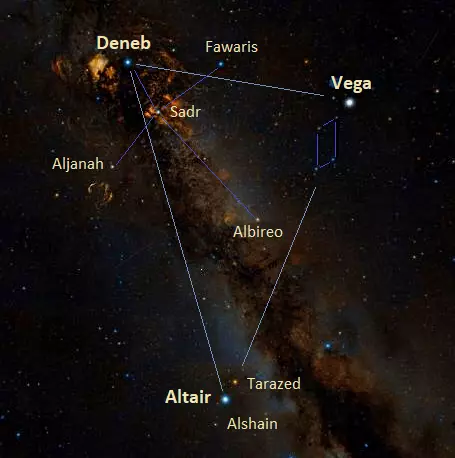
The Northern Cross and the Summer Triangle, image: Wikisky
Fawaris lies within 3° of the precessional path of the north celestial pole. It will become the North Star around the year 11,600 CE. It will succeed its Northern Cross neighbour Deneb as the pole star and keep the title until the bright Vega in the constellation Lyra takes over around the year 13,700 CE. Fawaris will not be as accurate a marker of true north as Polaris, which comes within 0.5° of the north celestial pole. However, it will be easier to find because it is part of a brighter asterism (the Northern Cross) than Polaris (the Little Dipper).
Name
The name Fawaris (pronunciation: /fəˈwɛərɪs/) comes from the Arabic al-Fawāris, meaning “the riders.” It once applied to an Arabic asterism formed by Fawaris with Sadr (Gamma Cygni), Aljanah (Epsilon Cygni), and Zeta Cygni. The name was approved by the International Astronomical Union’s (IAU) Working Group on Star Names (WGSN) on June 1, 2028. It formally applies only to the component Delta Cygni A.
In Chinese astronomy, Delta Cygni was known as the Second Star of Celestial Ford (天津二). It was part of an asterism called Celestial Ford along with Sadr (Gamma Cygni), Aljanah (Epsilon Cygni), 30 Cygni, Deneb (Alpha Cygni), Nu Cygni, Tau Cygni, Upsilon Cygni, and Zeta Cygni. The asterism was part of the Girl mansion, one of the northern mansions of the Black Tortoise.
Location
Fawaris is easy to find because it is both bright and part of a recognizable star pattern (the Northern Cross). It marks the wing of the celestial Swan. The Northern Cross is particularly prominent during the northern hemisphere summer, when it is high overhead in the evening night sky.
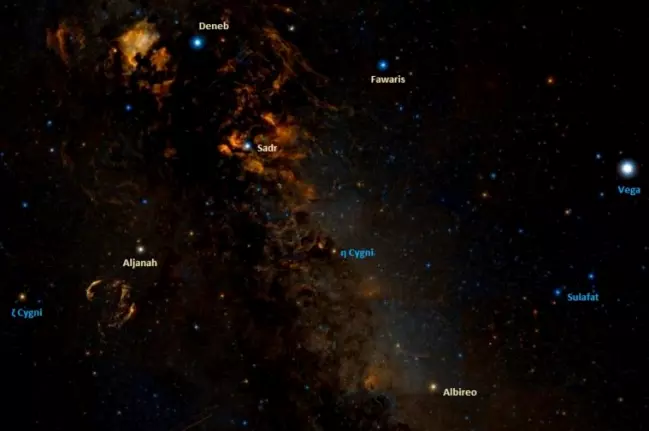
The Northern Cross, image: Wikisky
Fawaris can be used to find the open cluster NGC 6811, which lies just to the northeast. The cluster has a visual magnitude of 6.8 and an apparent size of 13 arcseconds, about half that of the full Moon. It lies at an approximate distance of 3,600 light-years. It has been nicknamed “The Hole in the Cluster” because it has a dark centre.
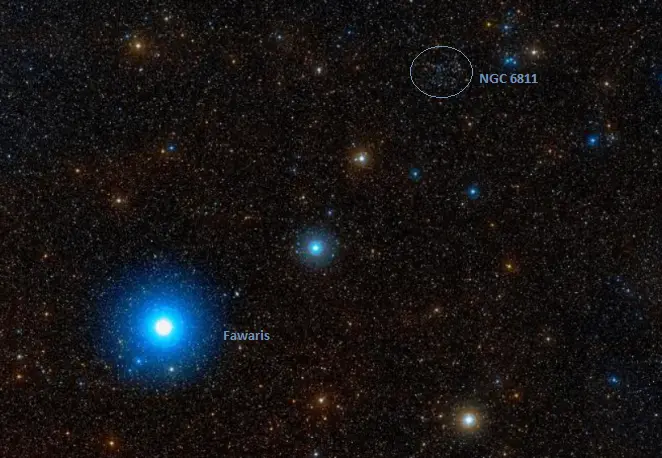
Fawaris and NGC 6811, image: Wikisky
Constellation
Fawaris is located in the constellation Cygnus, the Swan. Cygnus is one of the Greek constellations, first listed by Claudius Ptolemy in his Almagest in the 2nd century CE. It is associated with the myth of Zeus disguising himself into a swan to seduce Leda, the queen of Sparta.
Cygnus hosts many notable stars, among them Deneb, the 19th brightest star in the sky, the red hypergiant NML Cygni, one of the largest stars known, the Sun-like stars Kepler-22 and Kepler-11, the home of six transiting exoplanets, the yellow-white supergiant Sadr, the luminous blue variable P Cygni, and the high proper motion star 61 Cygni (Bessel’s Star).
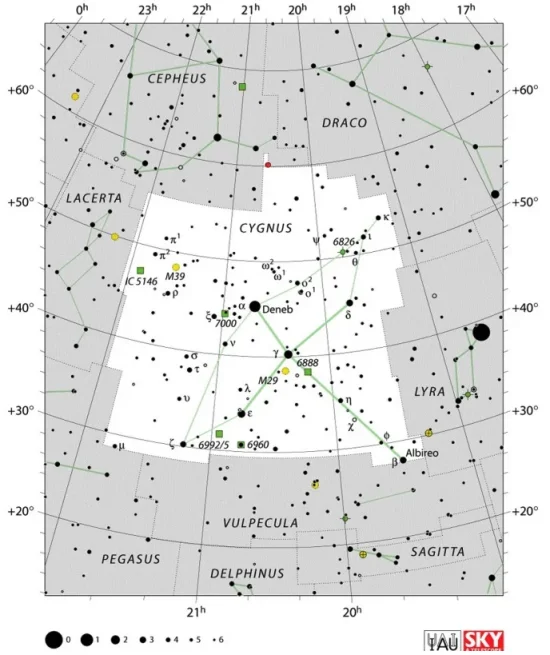
Cygnus constellation map by IAU and Sky&Telescope magazine
The constellation contains many well-known deep sky objects. These include the spiral galaxy NGC 6946 (the Fireworks Galaxy), the bright open clusters Messier 29, Messier 39 and the Rocking Horse Cluster (NGC 6910), the planetary nebulae NGC 6826 (the Blinking Planetary Nebula) and the Soap Bubble Nebula (PN G75.5+1.7), and the emission nebulae NGC 7000 (the North America Nebula), NGC 6888 (the Crescent Nebula), and IC 1318 (the Sadr Region).
The best time of the year to see the stars and deep sky objects in Cygnus is during the month of September, when the constellation is high above the horizon in the evening. The entire constellation is visible from all locations north of the latitude 40° S.
The 10 brightest stars in Cygnus are Deneb (Alpha Cyg, mag. 1.25), Sadr (Gamma Cyg, mag. 2.23), Aljanah (Epsilon Cyg, mag. 2.48), Fawaris (Delta Cyg, mag. 2.87), Albireo (Beta Cyg, mag. 2.90), Zeta Cygni (mag. 3.21), Xi Cygni (mag. 3.73), Tau Cygni (mag. 3.65 – 3.75), Iota2 Cygni (mag. 3.77), and Kappa Cygni (mag. 3.814).
Fawaris – Delta Cygni
| Spectral class | A0 IV (B9 III + F1 V) |
| Variable type | Suspected |
| U-B colour index | -0.10 |
| B-V colour index | -0.02 |
| Apparent magnitude | 2.87 |
| Absolute magnitude | -0.74 |
| Distance | 165 ± 4 light-years (51 ± 1 parsecs) |
| Parallax | 19.5064 ± 0.8016 mas |
| Radial velocity | -23.60 km/s |
| Proper motion | RA: +37.838 ± 1.421 mas/yr |
| Dec.: +51.932 ± 1.270 mas/yr | |
| Mass | 2.93 M☉ |
| Luminosity | 155 L☉ |
| Radius | 5.13 R☉ |
| Temperature | 10,150 K |
| Rotational velocity | 135 km/s |
| Surface gravity | 3.49 cgs |
| Constellation | Cygnus |
| Right ascension | 19h 44m 58.4827665645s |
| Declination | +45° 07′ 50.861316580″ |
| Names and designations | Fawaris, Delta Cygni, δ Cyg, 18 Cygni, HD 186882, HR 7528, HIP 97165, SAO 48796, BD+44°3234, AG+45 1581, PLX 4647, PPM 58782, GC 27347, GCRV 12126, IRAS 19434+4500, 2MASS J19445845+4507507, UBV 16830, ALS 16390, TYC 3557-2486-1, Gaia DR2 2079784487999414656, ADS 12880 A, CCDM J19450+4508A, WDS J19450+4508AB |